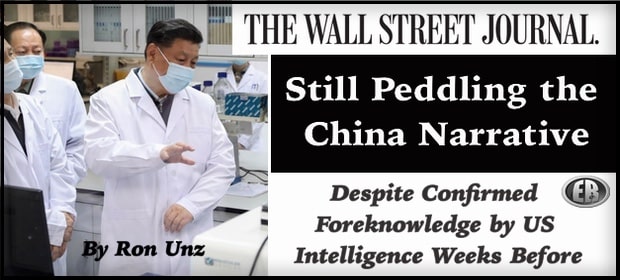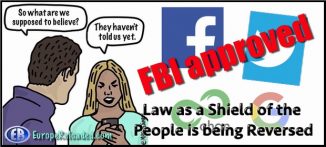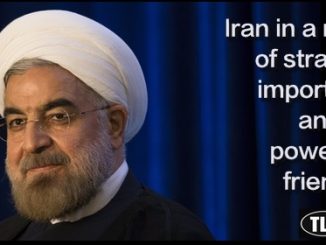
ER Editor: We’re republishing Ron Unz‘s review piece, prompted by a recent WSJ article about China’s response to the virus (‘China’s CDC, Built to Stop Pandemics Like Covid, Stumbled When It Mattered Most’), through the lens of Paul Craig Roberts’ blunt question.
In sum, the WSJ – even at this late stage – has omitted some key reporting on the topic that its counterparts in other ‘respected’ MSM outlets put out, which Unz discusses below, namely that Israeli media revealed that US intelligence had warned both Israel and NATO about the Wuhan outbreak in November, quite some time before the Chinese CDC apparently knew about it. As well as the sudden and heavy impact of the virus in Iran and on some of its top government officials, coming just weeks after the assassination of Qassem Soleimani.
We also remind readers of articles we’ve published before showing how the World Military Games in Wuhan during October were a likely time when a ‘virus’ may have been brought in (or at least disseminated in some way) because of so many young athletes from many countries getting sick. (See COVID: Why We Need to Pay Very Close Attention to Those Wuhan Military Games and Was Coronavirus a Biowarfare Attack Against China? A Veteran Insider Speaks Out.)
********
How Did Washington Know Before It Happened That There Would Be A Covid Outbreak In China?
How Did Washington Know Before It Happened That There Would Be A Covid Outbreak In China?
“It therefore appears that elements of the Defense Intelligence Agency were aware of the deadly viral outbreak in Wuhan more than a month before any officials in the Chinese government itself. Unless our intelligence agencies have pioneered the technology of precognition, I think this may have happened for the same reason that arsonists have the earliest knowledge of future fires.”
********
Half a Pulitzer Prize to the Wall Street Journal
RON UNZ
For forty years I carefully read the New York Times in hard copy each and every morning, eager to discover what had transpired since the previous day. But just in the last few months, my commitment has begun to flag, and my eyes often only lightly glance at half or more of the articles and their columnar headlines.
I’d never thought much of Donald Trump, but can’t seem to work up the enthusiasm to read yet another article headlining the “lies” of our Great Satan or his coterie of lesser Satans. The endless villainies of his Luciferian ally Vladimir Putin have grown dull to my mental tongue. The diabolical wickedness of China, whom Trump had supposedly so recently courted, elicits little interest. Closer to home, my eyes skip over another “social distancing” advice column about Covid-19, or further explanations of how “peaceful protesters” had recently set a government building on fire in Portland, Oregon, or destroyed Chicago’s wealthiest downtown shopping district.
The Business Section reports that the worst disease outbreak in a century, the worst unemployment since the Great Depression, and the worst national rioting in two generations has produced unprecedented gains in share prices on Wall Street, but the staff writers have apparently forgotten the word “bubble.” Many days the Arts Section seems to have become almost monochromatically black. So my daily regular morning ritual now takes much less time than it did in the past.
I can’t exactly plot the trajectory of this sharp drop in my recent interest. But I certainly noticed the change not longer after a Twitter-mob forced the Times to summarily purge for insufficient “wokeness” its highly-regarded Editorial Page Editor, widely considered a leading contender to run the paper, perhaps suggesting that the journalists changed their coverage and writing style to avoid a similar fate. I had always read my morning newspapers at a local coffee-shop, but the Coronavirus outbreak ended that possibility, thereby disrupting my routine. And my years of denouncing the dishonesty of “Our American Pravda” in my own articles may have finally begun to register in my own mind.
There are occasional exceptions to this pattern. Earlier this month the Times carefully tabulated our national mortality figures and determined that our “excess deaths” from early March to the end of July had already exceeded 200,000, indicating that the American body-count from our Covid-19 epidemic was considerably larger than generally assumed, and might even reach the half million mark by the end of the year. But examples of such solid reporting seem few and far between these days.
The obvious decline of the Times is especially apparent to me each morning when I compare it with the rival Wall Street Journal, which I read immediately afterward. After Rupert Murdoch acquired the Journal in 2007, most observers predicted a sad fate at the hands of the proprietor whose early Fleet Street media empire had been built upon on the frontal nudity of the Page Three Girls of his tabloid Sun. But Murdoch totally confounded those skeptics, providing his new flagship broadsheet with huge financial backing and a hands-off editorial policy, thereby elevating it from a business-focused publication to a near-peer rival to the Gray Lady at a time when so many other papers were about to begin shriveling from massive loss of advertising. Within a couple of years, even such inveterate Murdoch-haters as The Nation acknowledged this surprising reality.
Superb journalist resources unshackled by extreme “political correctness” allow an outstanding product, and this has certainly been demonstrated by the Journal‘s regular front-page investigative reports. A few days ago, our continuing Covid-19 disaster prompted yet another of these, which I think lacked only a few crucial elements to be worthy of a Pulitzer Prize.
Numerous publications have documented America’s severe mistakes in combating the disease, but this 4,500 word WSJ report focused upon the serious mishandling of the original outbreak by Chinese authorities. (ER: the date of this WSJ piece is recent – August 17, 2020.)
The article revealed that top public health officials at China’s Center for Disease Control only became aware of the situation on December 30th, when they learned that at least 25 suspected cases of a mysterious illness had already occurred in Wuhan during that month. But as the writers noted, the outbreak had certainly begun somewhat earlier:
Even a fully empowered China CDC would likely have missed the very first cases of the coronavirus, which probably began spreading around Wuhan in October or November, most likely in people who never showed symptoms, or did but never saw a doctor, researchers say.
All of this new information seems quite consistent with what had previously been discovered by America’s leading media outlets. But the Journal writers seem to have missed one additional fact that could have elevated this important story from a mundane investigation to a sensational expose. Although they documented that the Chinese government only learned of the Wuhan outbreak at the end of December, they seemed unaware that more than a month earlier American intelligence officials had distributed a secret report to our military allies describing the “cataclysmic” disease outbreak then underway in Wuhan.
A few months ago, I had noted the clear implications of this bizarre discrepancy in timing:
For obvious reasons, the Trump Administration has become very eager to emphasize the early missteps and delays in the Chinese reaction to the viral outbreak in Wuhan, and has presumably encouraged our media outlets to direct their focus in that direction.
As an example of this, the Associated Press Investigative Unit recently published a rather detailed analysis of those early events purportedly based upon confidential Chinese documents. Provocatively entitled “China Didn’t Warn Public of Likely Pandemic for 6 Key Days”, the piece was widely distributed, running in abridged form in the NYT and elsewhere. According to this reconstruction, the Chinese government first became aware of the seriousness of this public health crisis on Jan. 14th, but delayed taking any major action until Jan. 20th, a period of time during which the number of infections greatly multiplied.
Last month, a team of five WSJ reporters produced a very detailed and thorough 4,400 word analysis of the same period, and the NYT has published a helpful timeline of those early events as well. Although there may be some differences of emphasis or minor disagreements, all these American media sources agree that Chinese officials first became aware of the serious viral outbreak in Wuhan in early to mid-January, with the first known death occurring on Jan. 11th, and finally implemented major new public health measures later that same month. No one has apparently disputed these basic facts.
But with the horrific consequences of our own later governmental inaction being obvious, elements within our intelligence agencies have sought to demonstrate that they were not the ones asleep at the switch. Earlier this month, an ABC News story cited four separate government sources to reveal that as far back as late November, a special medical intelligence unit within our Defense Intelligence Agency had produced a report warning that an out-of-control disease epidemic was occurring in the Wuhan area of China, and widely distributed that document throughout the top ranks of our government, warning that steps should be taken to protect US forces based in Asia. After the story aired, a Pentagon spokesman officially denied the existence of that November report, while various other top level government and intelligence officials refused to comment. But a few days later, Israeli television mentioned that in November American intelligence had indeed shared such a report on the Wuhan disease outbreak with its NATO and Israeli allies, thus seeming to independently confirm the complete accuracy of the original ABC News story and its several government sources.
It therefore appears that elements of the Defense Intelligence Agency were aware of the deadly viral outbreak in Wuhan more than a month before any officials in the Chinese government itself. Unless our intelligence agencies have pioneered the technology of precognition, I think this may have happened for the same reason that arsonists have the earliest knowledge of future fires.
An entirely new disease that spreads in silent, asymptomatic fashion can easily escape initial detection, and we should not be surprised that no one in China noticed the Wuhan outbreak when it first began in October or November. But America’s intelligence operatives were entirely aware of what was happening from the very beginning, and began informing all our allies.
This seems about as close to a “smoking gun” as we can ever likely to encounter in the annals of the murky world of intelligence operations.
Moreover, I have also noted the very unusual international pattern the deadly disease immediately began to follow:
As the coronavirus gradually began to spread beyond China’s own borders, another development occurred that greatly multiplied my suspicions. Most of these early cases had occurred exactly where one might expect, among the East Asian countries bordering China. But by late February, Iran had become the second epicenter of the global outbreak. Even more surprisingly, its political elites had been especially hard-hit, with a full 10% of the entire Iranian parliament soon infected and at least a dozen of its officials and politicians dying of the disease, including some who were quite senior. Indeed, Neocon activists on Twitter began gleefully noting that their hatred Iranian enemies were now dropping like flies.
Let us consider the implications of these facts. Across the entire world the only political elites that have yet suffered any significant human losses have been those of Iran, and they died at a very early stage, before significant outbreaks had even occurred almost anywhere else in the world outside China. Thus, we have America assassinating Iran’s top military commander on Jan. 2nd and then just a few weeks later large portions of the Iranian ruling elites became infected by a mysterious and deadly new virus, with many of them soon dying as a consequence. Could any rational individual possibly regard this as a mere coincidence?
So if the journalists at the WSJ had merely taken note of what had previously been reported by ABC News and confirmed by Israeli television, they would surely have earned themselves a Pulitzer Prize. But earning and receiving are two separate matters, and they might easily have instead been purged for treading upon such touchy national security matters. After all, our own webzine was banned by both Facebook and Google just days after we raised these same matters.
Such retaliation helps explain why our American mainstream media has long since concluded that discretion is the better part of valor.
************
Original article

••••
The Liberty Beacon Project is now expanding at a near exponential rate, and for this we are grateful and excited! But we must also be practical. For 7 years we have not asked for any donations, and have built this project with our own funds as we grew. We are now experiencing ever increasing growing pains due to the large number of websites and projects we represent. So we have just installed donation buttons on our websites and ask that you consider this when you visit them. Nothing is too small. We thank you for all your support and your considerations … (TLB)
••••
Comment Policy: As a privately owned web site, we reserve the right to remove comments that contain spam, advertising, vulgarity, threats of violence, racism, or personal/abusive attacks on other users. This also applies to trolling, the use of more than one alias, or just intentional mischief. Enforcement of this policy is at the discretion of this websites administrators. Repeat offenders may be blocked or permanently banned without prior warning.
••••
Disclaimer: TLB websites contain copyrighted material the use of which has not always been specifically authorized by the copyright owner. We are making such material available to our readers under the provisions of “fair use” in an effort to advance a better understanding of political, health, economic and social issues. The material on this site is distributed without profit to those who have expressed a prior interest in receiving it for research and educational purposes. If you wish to use copyrighted material for purposes other than “fair use” you must request permission from the copyright owner.
••••
Disclaimer: The information and opinions shared are for informational purposes only including, but not limited to, text, graphics, images and other material are not intended as medical advice or instruction. Nothing mentioned is intended to be a substitute for professional medical advice, diagnosis or treatment.





